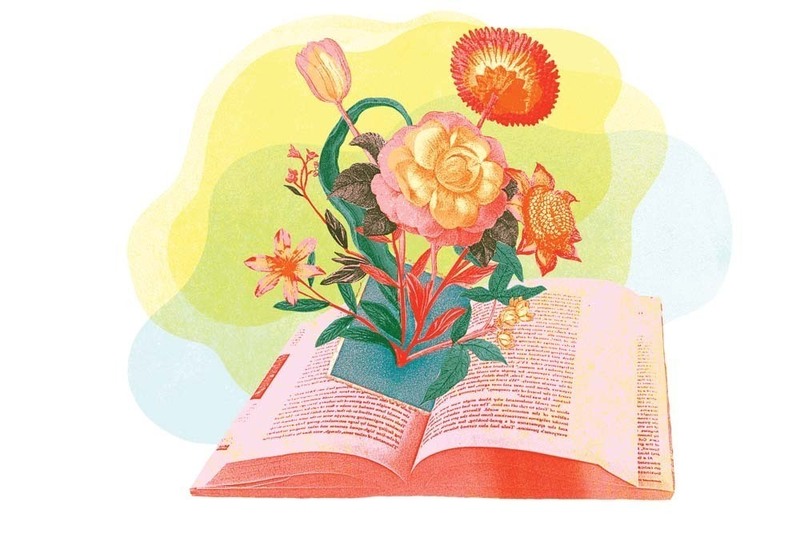 Illustration by Marianne Chevalier
Illustration by Marianne Chevalier
Last year my 94-year-old grandparents moved from their longtime home in Pennsylvania to a senior living facility. My parents, who assisted with the move, returned home with a folder of photographs of Nana and Pops to share with my brothers and me.
I selected an image of my grandparents that was taken the day after their engagement. The two of them lean to the left, whether due to the sloping landscape or the photographer’s angle. Such tilting might be how their world felt then: a little off kilter. In one another’s grasp, they recalibrate their centers of mass.
I am invested in the couple’s destiny. Like any favorite story, I know the outcome — effectively, I am an outcome. Still, I am caught up in the drama. Look how beautiful she is, I want to say to him. Feel how steady he is, I want to tell her. As if they need encouragement. Whatever attraction they feel toward each other, I want to breathe life into it, fan the flames.
Nana’s dress dimples into a shadow where Pops’ hand grips her waist. Knowing many waists are gripped then released, that such embraces do not always endure for 70 years, I note the crease. Is such longevity in monogamy natural? This miracle of married stability is due, in part, to the couple’s looking outward in the same direction, just as they look at the camera’s lens.
Not pictured is Pops’ hand, behind Nana’s back. I consider Pops’ signature gestures as my family reversed out of my grandparents’ driveway so many times when departing Pennsylvania for Virginia. Pops would pretend to dismiss the sentimentality of departure by flicking his hands downward and turning his head away; he infused the farewell with humor. Then, as if in afterthought, his hands transformed into “I love you” signs — curiously, not raised aloft; rather, his fingers jabbed forward as though prodding us toward the interstate.
Nana’s right arm, also hidden in the photograph, is a cookie-batter-stirring, turkey-roasting, afghan-knitting, letter-writing arm. I imagine a time-lapse video of Nana receiving 18 grandchildren: She used to scoop us off the floor; in the video, her arms rise overhead like goalposts. We sail through the uprights, planting a kiss for an extra point.
In the photograph, my grandparents stand in front of a chain-link fence, which recalls a time Nana pointed out to me the fenced cemetery where she and Pops would be buried. It seemed a morbid notion for a sunny morning drive, but with Nana as its source I figured it must signal generosity. Her comment introduced me to the concept of forethought regarding end-of-life arrangements.
Seeing now the fence in the photograph, I allow it to act as a symbol for life’s boundary. My grandparents smile and clutch each other on this side of the barrier; beyond, a lawn contains trees and indistinct figures near the horizon. The black-and-white image prompts artistic license. I picture the grass green as if Technicolored; I add leaves to the branches. I, too, can play the game of forethought.
I see in Pops’ face those of some cousins: Colin, Patrick, Danny. I wouldn’t bring it up — I’d rather someone else say it, as confirmation — but if someone looked at Nana’s face and said they could see me in it, I would be pleased. Noting her pale, round, smiling face and her curled bob, I’d agree.
Without a frame for the photograph, and not wanting to lose it, I can’t think of a better place to put it than into the book I am reading. I hesitate, feeling like I am putting my grandparents on par with a torn envelope or grocery receipt as a makeshift bookmark. I do not wish to demean them but feel the closed book at least will hold them flat. The process of pressing flowers presents itself as consolation. Aha! The photo contains fleeting beauties I am pressing in preservation.
Mid-chapter, I insert the photograph toward the spine. Into the narrative, which is neither their story nor my story, which but for the flip of a few pages might be any of our stories, I tuck my grandparents’ image from the past to hold my place for the future.
Erin Buckley lives in Richmond, Virginia. Her grandparents, Ernest Buckley ’53 and Mary Conroy Buckley, were engaged at Notre Dame’s Grotto the weekend of the Senior Ball, May 1953, and were married three months later. Their six children are graduates either of Notre Dame or of Saint Mary’s College.